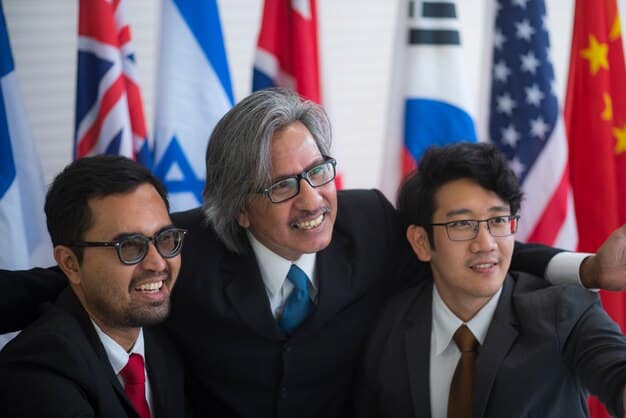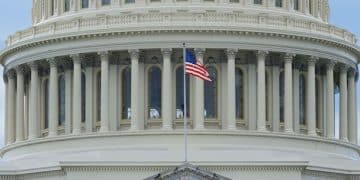US-North Korea Relations: Analyzing Recent Developments & Future Prospects

Analyzing the US Relationship with North Korea: Recent Developments and Future Prospects involves understanding the complex interplay of diplomacy, denuclearization efforts, and geopolitical strategies amid ongoing tensions and fluctuating dialogues.
The relationship between the United States and North Korea has long been a subject of intense global scrutiny. Analyzing the US Relationship with North Korea: Recent Developments and Future Prospects requires a multifaceted approach, considering political shifts, economic sanctions, and security concerns that shape this intricate dynamic.
Historical Context of US-North Korea Relations
Understanding the current state of US-North Korea relations requires a look back at the history that has shaped it. The Korean War and the subsequent armistice agreement set the stage for decades of animosity and mistrust.
The origins of the strained relationship between the United States and North Korea can be traced back to the Korean War (1950-1953). This conflict, which pitted the communist North against the US-backed South, ended in a stalemate, but it solidified a deep-seated hostility that has persisted for decades.
Key Historical Events
Several key events have marked the trajectory of US-North Korea relations. The capture of the USS Pueblo in 1968, various nuclear crises in the 1990s and 2000s, and numerous missile tests have all contributed to escalating tensions and diplomatic challenges.
- Korean War (1950-1953): The foundational conflict that established lasting animosity.
- USS Pueblo Incident (1968): A spy ship captured by North Korea, increasing tensions.
- Nuclear Crises (1990s-2000s): North Korea’s nuclear ambitions causing international alarm.

These historical incidents have created a cycle of provocation, condemnation, and negotiation, making it challenging to establish a stable and predictable relationship.
Recent Developments in the Relationship
Recent years have seen periods of intense diplomatic engagement followed by renewed tensions. The Trump administration’s approach, characterized by direct summits with Kim Jong-un, marked a significant departure from traditional diplomatic strategies.
The Trump administration’s engagement with North Korea was marked by unprecedented direct diplomacy. Several summits were held, leading to high hopes for a breakthrough in denuclearization talks.
The Trump-Kim Summits
The summits in Singapore, Hanoi, and the DMZ generated optimism but ultimately failed to produce a concrete agreement on denuclearization. The lack of consensus on sanctions relief and the specifics of North Korea’s disarmament remained major stumbling blocks.
- Singapore Summit (2018): Initial meeting yielding broad commitments.
- Hanoi Summit (2019): Talks collapsed due to disagreements on sanctions.
- DMZ Meeting (2019): A symbolic gesture but no substantial progress.
Following these summits, relations reverted to a more cautious stance, with both sides maintaining their positions and engaging in limited dialogue.
The Biden Administration’s Approach
The Biden administration has adopted a more calibrated approach, emphasizing a combination of diplomacy and deterrence. This strategy seeks to balance maintaining pressure on North Korea through sanctions while remaining open to dialogue.
The current administration’s strategy includes keeping existing sanctions in place while signaling a willingness to meet with North Korean officials without preconditions.
Key Policy Elements
The Biden administration’s approach involves working closely with allies in the region, such as South Korea and Japan, to present a united front. This coordinated effort aims to increase pressure on North Korea to return to the negotiating table.
- Allied Coordination: Strengthening ties with South Korea and Japan.
- Sanctions Enforcement: Maintaining pressure on North Korea.
- Open Dialogue: Willingness to meet without preconditions.
The Biden administration hopes that this approach will create a more conducive environment for future negotiations while ensuring regional stability.

North Korea’s Nuclear Program
North Korea’s pursuit of nuclear weapons remains a central challenge in US-North Korea relations. Despite international sanctions and diplomatic efforts, North Korea has continued to develop and test its nuclear arsenal.
North Korea has consistently defied international norms by continuing its nuclear program, posing a significant threat to regional and global security.
Current Status of the Program
Recent reports suggest that North Korea is continuing to enhance its nuclear capabilities. This includes developing more sophisticated weapons and delivery systems, as well as expanding its nuclear facilities.
- Continued Development: Enhancing nuclear weapons technology.
- Delivery Systems: Improving missile capabilities.
- Facility Expansion: Increasing nuclear infrastructure.
Addressing North Korea’s nuclear program requires a comprehensive strategy that combines diplomatic engagement with robust deterrence measures.
Economic Factors and Sanctions
Economic considerations play a significant role in shaping US-North Korea relations. Sanctions imposed by the United States and the international community aim to pressure North Korea to abandon its nuclear weapons program.
Economic sanctions are intended to limit North Korea’s ability to fund its weapons programs, but they also have a significant impact on the country’s economy.
Impact of Sanctions
Sanctions have had a mixed impact, limiting North Korea’s access to international markets and financial resources while also causing hardship for the general population. The effectiveness of sanctions depends on consistent enforcement and international cooperation.
- Limited Access: Reduced international trade.
- Financial Constraints: Restricting funding for weapons programs.
- Humanitarian Impact: Hardship for the North Korean population.
Balancing the need to pressure North Korea with the humanitarian consequences of sanctions remains a critical challenge.
Future Prospects and Potential Scenarios
The future of US-North Korea relations remains uncertain. Several potential scenarios could unfold, ranging from continued tensions and limited engagement to renewed diplomacy and progress on denuclearization.
Various factors, including leadership changes, shifts in geopolitical dynamics, and internal developments within North Korea, could influence the trajectory of the relationship.
Possible Future Paths
One possible scenario is continued deadlock, with neither side willing to make significant concessions. Another scenario involves a return to active diplomacy, potentially leading to a gradual easing of tensions and progress on denuclearization. A third scenario could involve further escalation, with increased military posturing and heightened risks of conflict.
- Continued Deadlock: No significant progress or concessions.
- Renewed Diplomacy: Gradual easing of tensions and dialogue.
- Escalation: Increased military posturing and conflict risks.
Successfully navigating the complexities of US-North Korea relations requires a flexible and adaptive approach that takes into account the evolving dynamics of the region.
| Key Point | Brief Description |
|---|---|
| 🇰🇵 Nuclear Program | North Korea’s pursuit of nuclear weapons despite sanctions. |
| 🤝 Diplomacy Efforts | Trump and Biden administrations’ approaches to dialogue. |
| 🚫 Economic Sanctions | Impact of sanctions on North Korea’s economy and population. |
| 🌍 Regional Stability | Importance of allied coordination for maintaining peace. |
Frequently Asked Questions
▼
The primary issue revolves around North Korea’s nuclear weapons program, which the US and international community want to dismantle. Negotiations have been on and off for decades.
▼
Approaches have varied. Some presidents have favored sanctions and pressure, while others, like Trump, pursued direct diplomacy. Biden emphasizes allied coordination and open dialogue.
▼
Sanctions aim to cut off funding for North Korea’s nuclear program. However, they also impact the country’s economy and its citizens, creating a complex humanitarian challenge.
▼
Denuclearization talks have stalled significantly. Despite past summits, there hasn’t been a concrete agreement on dismantling North Korea’s nuclear arsenal in exchange for sanctions relief.
▼
Future outcomes vary. It could remain deadlocked, see renewed diplomacy, or escalate into conflict, making it crucial to adapt to evolving dynamics for effective solutions.
Conclusion
Analyzing the US Relationship with North Korea: Recent Developments and Future Prospects reveals a complex and evolving geopolitical challenge. From the historical context of the Korean War to recent diplomatic efforts and the ongoing pursuit of nuclear weapons, the relationship between the US and North Korea demands careful consideration and strategic engagement to foster stability and security in the region.





